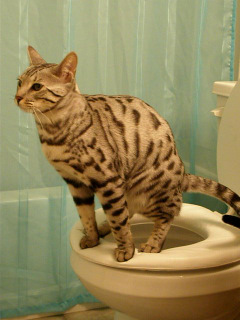Dangers of Disposing Cat Poop in Your Toilet - Precautionary Steps
Dangers of Disposing Cat Poop in Your Toilet - Precautionary Steps
Blog Article
Just about everyone may have their own way of thinking about How to Dispose of Cat Poop and Litter Without Plastic Bags.

Introduction
As pet cat owners, it's important to bear in mind exactly how we dispose of our feline good friends' waste. While it might appear practical to flush feline poop down the commode, this method can have harmful repercussions for both the atmosphere and human health and wellness.
Ecological Impact
Purging pet cat poop presents hazardous microorganisms and parasites right into the water, posing a substantial threat to marine ecosystems. These impurities can negatively affect aquatic life and compromise water quality.
Health Risks
In addition to environmental concerns, flushing pet cat waste can additionally posture health and wellness dangers to humans. Cat feces might have Toxoplasma gondii, a bloodsucker that can trigger toxoplasmosis-- a possibly extreme health problem, especially for pregnant females and people with weakened immune systems.
Alternatives to Flushing
Fortunately, there are much safer and much more responsible means to dispose of pet cat poop. Think about the complying with options:
1. Scoop and Dispose in Trash
The most common method of dealing with pet cat poop is to scoop it right into a naturally degradable bag and throw it in the garbage. Make sure to use a dedicated clutter scoop and dispose of the waste without delay.
2. Use Biodegradable Litter
Choose biodegradable cat clutter made from materials such as corn or wheat. These litters are eco-friendly and can be safely dealt with in the garbage.
3. Bury in the Yard
If you have a backyard, take into consideration burying pet cat waste in a marked area far from vegetable gardens and water sources. Make certain to dig deep enough to stop contamination of groundwater.
4. Set Up a Pet Waste Disposal System
Invest in a pet dog garbage disposal system especially developed for pet cat waste. These systems make use of enzymes to break down the waste, minimizing smell and environmental effect.
Verdict
Accountable animal ownership expands beyond supplying food and shelter-- it likewise entails appropriate waste monitoring. By refraining from purging pet cat poop down the toilet and selecting alternate disposal approaches, we can reduce our ecological footprint and safeguard human wellness.
Why Can’t I Flush Cat Poop?
It Spreads a Parasite
Cats are frequently infected with a parasite called toxoplasma gondii. The parasite causes an infection called toxoplasmosis. It is usually harmless to cats. The parasite only uses cat poop as a host for its eggs. Otherwise, the cat’s immune system usually keeps the infection at low enough levels to maintain its own health. But it does not stop the develop of eggs. These eggs are tiny and surprisingly tough. They may survive for a year before they begin to grow. But that’s the problem.
Our wastewater system is not designed to deal with toxoplasmosis eggs. Instead, most eggs will flush from your toilet into sewers and wastewater management plants. After the sewage is treated for many other harmful things in it, it is typically released into local rivers, lakes, or oceans. Here, the toxoplasmosis eggs can find new hosts, including starfish, crabs, otters, and many other wildlife. For many, this is a significant risk to their health. Toxoplasmosis can also end up infecting water sources that are important for agriculture, which means our deer, pigs, and sheep can get infected too.
Is There Risk to Humans?
There can be a risk to human life from flushing cat poop down the toilet. If you do so, the parasites from your cat’s poop can end up in shellfish, game animals, or livestock. If this meat is then served raw or undercooked, the people who eat it can get sick.
In fact, according to the CDC, 40 million people in the United States are infected with toxoplasma gondii. They get it from exposure to infected seafood, or from some kind of cat poop contamination, like drinking from a stream that is contaminated or touching anything that has come into contact with cat poop. That includes just cleaning a cat litter box.
Most people who get infected with these parasites will not develop any symptoms. However, for pregnant women or for those with compromised immune systems, the parasite can cause severe health problems.
How to Handle Cat Poop
The best way to handle cat poop is actually to clean the box more often. The eggs that the parasite sheds will not become active until one to five days after the cat poops. That means that if you clean daily, you’re much less likely to come into direct contact with infectious eggs.
That said, always dispose of cat poop in the garbage and not down the toilet. Wash your hands before and after you clean the litter box, and bring the bag of poop right outside to your garbage bins.
https://trenchlesssolutionsusa.com/why-cant-i-flush-cat-poop/

As a person who reads on Don’t flush cat feces down the toilet, I assumed sharing that piece of content was appropriate. Enjoyed reading our piece of writing? Please share it. Let another person check it out. Thanks for going through it.
Call Today Report this page